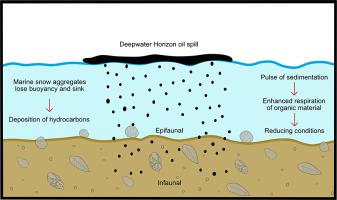Marine Micropaleontology ( IF 1.9 ) Pub Date : 2021-02-18 , DOI: 10.1016/j.marmicro.2021.101971 Chloe M.E. Young , Patrick T. Schwing , Laura J. Cotton

|
The 2010 Deepwater Horizon (DWH) oil spill released 4.0 million barrels of petroleum into the Northern Gulf of Mexico (NGoM), causing a substantial Marine Oil Snow, Sedimentation and Flocculent Accumulation (MOSSFA) event. Benthic foraminifera have successfully been used as bioindicators of the event with an 80–93% decline in density coinciding with the oil spill, followed by a recovery period to a steady state within three to five years. Here we present the results of a size and morphological study of four species of benthic foraminifera which remained abundant through the DWH oil spill (Uvigerina peregrina, Brizalina subaenariensis var. mexicana, Bulimina marginata and Cassidulina teretis) to understand how different species were impacted and why such a loss in density occurred. Short-lived radioisotope dating distinguished the pre-DWH and post-DWH depth intervals from 2010 to 2015. The species exhibit shape changes in response to the oil and MOSSFA processes and the pre-DWH length/width ratios of Uvigerina peregrina and Brizalina subaenariensis var. mexicana are significantly different than post-DWH length/width ratios within the cores. Reduced oxygen levels were likely a long-term (3–5 years) driver of this shape change and enhanced organic carbon concentrations were a short-term (1–2 years) driver. This study demonstrated the importance of the benthic foraminiferal morphological response to the DWH oil spill and furthers our understanding of the strategies of taxa that occurred abundantly throughout the record.
中文翻译:

底栖有孔虫对2010年深水地平线溢油的形态反应
2010年的深水地平线(DWH)漏油事件向墨西哥北部湾(NGoM)释放了400万桶石油,造成了严重的海洋油雪,沉积和絮凝物累积(MOSSFA)事件。底栖有孔虫已成功用作该事件的生物指示剂,其密度随漏油而下降了80-93%,随后在三到五年内恢复到稳定状态。在这里,我们介绍了通过DWH溢油(Uvigerina peregrina,Brizalina subaenariensis var。mexicana ,Bulimina marginata和Cassidulina teretis)保持丰富的四种底栖有孔虫物种的大小和形态研究的结果。),以了解不同物种受到的影响以及密度降低的原因。短期放射性同位素测年区分了2010年至2015年DWH前和DWH后的深度间隔。该物种响应于石油和MOSSFA过程以及Uvigerina peregrina和Brizalina subaenariensis var的DWH前长/宽比而显示形状变化。。墨西哥与核心内的DWH后长度/宽度比明显不同。降低氧气含量可能是这种形状变化的长期(3-5年)驱动力,而有机碳浓度升高是短期(1-2年)的驱动力。这项研究证明了底栖有孔虫形态反应对DWH溢油的重要性,并进一步加深了我们对整个记录中大量发生的分类单元策略的理解。



























 京公网安备 11010802027423号
京公网安备 11010802027423号